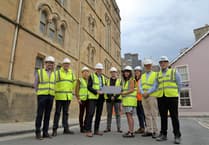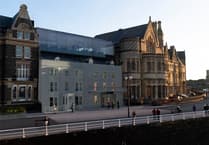A multi-million-pound renovation of Aberystwyth’s iconic seafront Old College will not be ready until at least the end of 2025, the university has said, but when finished will create more than 100 jobs and put the site “on a par” with Caernarfon Castle for tourism.
The restoration stage of the Old College project is set to get underway this week as work begins on the building’s stonework, windows and storm-damaged roof.
As the project progresses, funding from the UK Government’s Levelling Up Fund means the project is also to be extended to include the adjoining Cambria building.
With the Cambria included, the Old College project in its entirety is now expected to cost north of £43m investment.
Aberystwyth University originally wanted the revamped building - which will include a hotel as well as educational and community spaces - finished by last year in time to mark the institution’s 150th anniversary but delays including the pandemic moved the project back.
The target was then moved to summer 2024, but with extensive work still to be done the university now hopes to have the project completed by the end of 2025 – more than three years after it had originally planned.
The plan for the Grade I listed Old College will see it transformed into a cultural, learning, and enterprise facility for the university and includes a 33-bed, four-star hotel as well as space for events.
The scheme was approved unanimously in 2019 by Ceredigion County Council, whose planning officers gave Listed Building Consent for the project the green light last year.
The most controversial aspect of the scheme is a new glazed conference space that cantilevers over the Grade II listed Georgian Villas at 1 and 2 New Promenade, which attracted several objections as being “not in keeping” with the building.
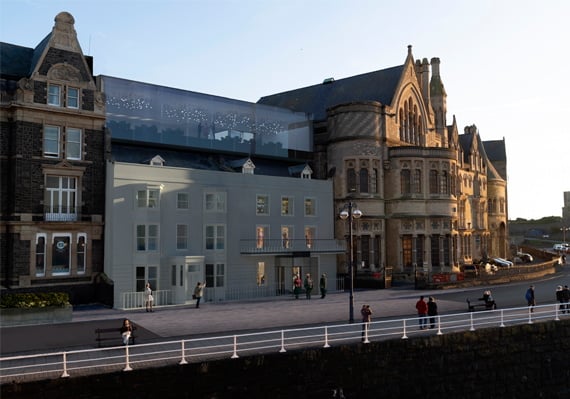
Council planners said the construction of the new building “will inevitably have some impact on the listed buildings,” and that it is “difficult to find new uses for large historic buildings such as the Old College that are viable in the long term.”
“Inevitably some compromises are required to ensure that they are preserved for future generations,” planners said.
The university has now said that in the coming weeks, “extensive scaffolding will be erected along the prom-facing side of the Old College to facilitate the restoration work, as the team aim to make the building water-tight before winter.”
The university said the start of restoration “marks an important milestone in the ambitious project.”
“It follows a year’s work that has focussed on the removal of both internal and external features that had been added to the historic site over more recent decades,” the university said.
That work has included removing the old Estates Building in King Street to make way for the new atrium, while 1960s additions to inside the building have also been removed.
“Respecting the heritage of the building is a priority and has required detailed architectural work to comply with the listed building consents necessary before work can be done on the Grade I listed building, work which will be ongoing as the project evolves,” the university said.
The main contractor on the Old College project is Port Talbot based construction company Andrew Scott Ltd.
Mark Bowen, managing director of Andrew Scott Ltd said: “We are energised by the complexity of this project as solving these kinds of challenges is very much at the heart of what we do.
“The Old College is a building that defines the seafront at Aberystwyth and we are excited to be playing a major role in restoring it to its former glory.”
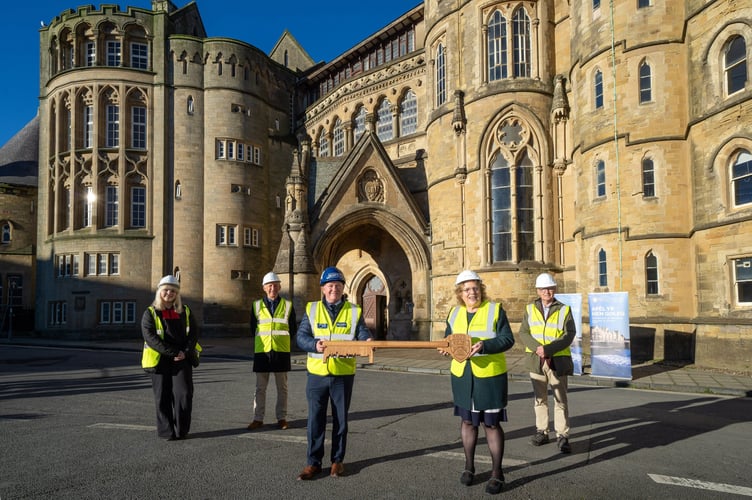
Dr Rhodri Llwyd Morgan, executive lead for Aberystwyth University on the Old College project said: “We are delighted to see work on Old College progress onto the restoration phase.
“This is a complex and challenging project that has required detailed design and preparatory work and I am grateful to the whole project team and to the local conservation planning officers for their part in achieving progress to date.
“Our vision for the Old College offers huge potential for Aberystwyth, both for the university and the town, economically, socially and culturally, as well as securing the future of an architecturally fascinating building that has played such an important part in the history of modern Wales.”
The restoration phase of the project will involve work by specialist contractors, using materials that match those used originally as closely as possible.
Manchester-based Stoneguard have been commissioned to undertake the stonework, having worked on prestigious projects in Kew Gardens, the Natural History Museum and the Palace of Westminster.
The restoration and renovation of the Old College’s wooden windows is being undertaken by Cardigan based heritage carpenter Gary Davies, whose work includes the award-winning restoration of Cardigan Castle and Llwyngoras, Pembrokeshire which dates from the 16th century.
The mammoth task of reroofing the Old College is being taken on by heritage roof restoration specialists Greenough and Sons from Ynys Môn who have worked previously on the National Library of Wales and Castell Coch, and are currently working on Manchester Town Hall.
Finding matching building materials for the restoration reflects the history of its construction and reconstruction in its early years.
New sources of sandstone and limestone are being sought as the stone used for its construction in the 1860s and its rebuilding after the fire of 1885 is no longer being quarried.
All 664 window frames, in steel, stone and wood, will be individually restored in line with the buildings Grade I listed status.
An initial survey has revealed that many of the wooden frames facing King Street are of Douglas fir, whilst mahogany features in many that face the sea.
All replacement wood will be provided from sustainable sources.
Around 50,000 of the current roof slates are expected to be reused whilst 20,000 new ‘Heather Blue’ slates from the Penrhyn Quarry in Bethesda, Gwynedd, matching the colour and grain of the originals, will be used on the sea-facing side This will improve the building’s durability during stormy weather.
Added to these are the distinctive green slates on the turrets of South Seddon, the section of the Old College closest to the castle.
Also, up to three quarters of the lead on the roofs of the Old College will be reclaimed and melted down to be used once more on the building.
The purchase of the Cambria, home to the former Theological College for many years and office space more recently, has been fully funded by £5.4m from the UK Government through its Levelling Up Fund.
As phase two of the project, that building will provide conference and meeting facilities along with additional 4* hotel accommodation.
The university said that phase one of the project, which involves the Old College itself and the Georgian villas at 1 and 2 Marine Terrace is “expected to be completed around the end of 2025.”
The Cambria development is expected to take another year to be completed.
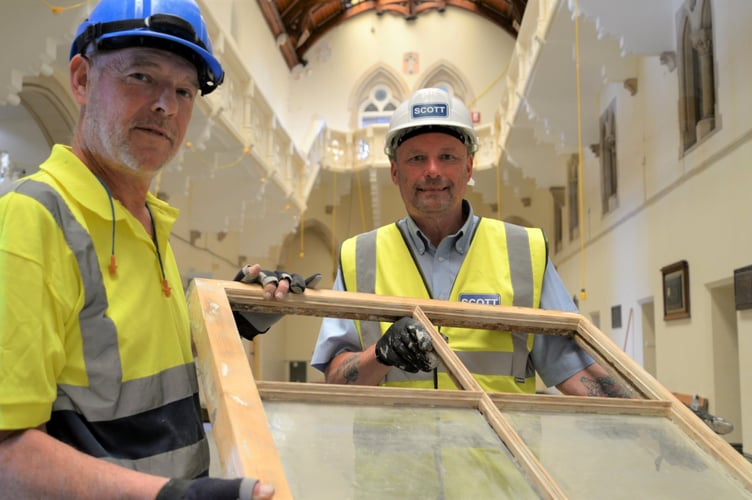
“The redeveloped Old College will provide a major centre for learning, heritage, culture and enterprise in three themed zones: World of Knowledge, Culture and Community, and Enterprise and Innovation,” the university said.
“Inspired by the University’s motto, World of Knowledge will include a centre celebrating pioneering Science and Research, a University Museum, a Young People’s project to provide opportunities to boost skills and aspirations and wellbeing, a 24-7 student study centre and a cutting-edge cinema facility.
“Traditionally the beating heart of the Old College, the Quad will provide the focus for the Community and Culture zone’s exhibition galleries that will feature curated displays from the University collections and touring exhibitions from major partners.
“This zone also includes the UK’s first Centre for Dialogue.
“The Enterprise and Innovation zone will provide 12 Creative Business Units and communal spaces to encourage young entrepreneurs in creative and digital businesses, two fast growing sectors of major economic importance to west Wales.”
Once completed the university said the Old College is “expected to attract 200,000 visitors and contribute up to £14.5m annually to the local economy”.
The university said that those figures would “put it on par with major tourist destinations such as Caernarfon and Conwy castles.”
“Up to 130 jobs will be created directly and indirectly and there will also be more than 400 volunteering opportunities,” the university added.
“There will be 4* hotel accommodation and spaces for activities and events across seven floors and 143 rooms, including 10 rooms with capacity ranging from 60 and up to 200 people.”
The Old College project is supported by The National Lottery Heritage Fund, Welsh Government and the European Regional Development Fund, the Coastal Communities Fund, The National Lottery Community Fund, philanthropic trusts, and individuals.





